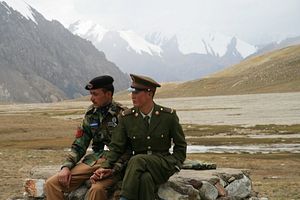If general impressions are to be believed, Chinese President Xi Jinping’s One-Belt-One-Road project—at least as it plays out in Pakistan and its neighborhood—is either a major step toward Chinese projection of power outside its borders, or an example of the importance of domestic constituencies in Chinese foreign policy. The first camp believes that the hesitancy and inherent conservatism of China is finally giving way to a more muscular and confident role, and that Chinese claims that its investment in infrastructure to its west and south is “win-win” for everyone is actually cover for a new manifestation of its global role. The latter believes that the foreign implications of the plan are secondary to the real issue on the Chinese leadership’s mind: the domestic Chinese economic transformation that will see cheap labor producing mass exports replaced by higher value-added production that depends on technological savvy and education.
On the other end of the One-Belt-One-Road project, in Pakistan for example, there is the prospect of an opening of an economy long stagnant, unleashing Pakistan’s potential in its labor force, accessibility of goods, and role in international trade. That, of course, is what the government of Prime Minister Sharif states, expecting that the 48 billion dollars expected to pour into infrastructure projects in Khyber Pakhtunkwa and Balochistan will transform the country, alleviating much of the poverty that has been increased by the violence and insecurity of recent decades. But it could in fact do no such thing. The economy of Pakistan has become more autarkic over time, as political elites defend their roles in traditional sectors like agriculture, textiles, and basic manufacturing, resisting the changes that have brought neighboring areas like Southeast Asia in to the world economy. Some suspect that the 48 billion, if steered toward political favorites and distributed in a non-transparent way, will simply reinforce the calcified system that favors traditional elites over innovation and flexibility.
Therefore, it’s worth watching how the One-Belt-One-Road initiative is implemented. If the Chinese administer it with an eye toward domestic constituencies, making sure that projects in places like Pakistan serve the needs of Chinese steel, cement, and construction industries, then the claims of a “win-win” system for its neighbors will ring hollow: it will be more an exercise in patronage than in gaining influence, and the focus on partners outside China will be more on what’s advantageous for key sectors of a faltering economy at home rather than what builds the basis for strong cooperation abroad for years to come.
Similarly, if the way the Pakistanis administer their end of the cooperative projects amounts to making sure that the friends of people in power gain access to contracts whether or not they produce the best results or have the best ideas, the One-Belt One-Road will do more to keep things as they are in Pakistan than to serve as the agent of true development that pushes the country into the 21st century and allows it to reach its potential in the world economy. If the partnership engages in high-visibility but low-impact infrastructure projects that many believe are more monuments to vanity than development achievements, it will not bring the kind of change that will have a fundamental impact on Pakistan. If the Chinese, following traditions of non-interference in the affairs of neighbors, don’t demand the transparency and oversight that investments of this sort demand, the impact on both countries will certainly be less than hoped and, at worst, increase the sense of illegitimacy and waste that bother the leadership of both countries so much.
In other words, the One-Belt-One-Road initiative, as it’s conceived between China and Pakistan, has the potential to have significant impact on both countries, burnishing China’s credentials as a subtle and generous partner to its neighbors and contributing to the much-needed transformation of the Pakistani economy from what some still call a feudal system. But if the interests of domestic constituencies in both countries override these broad goals, and the investment by the Chinese in the road and rails and ports from Baltistan to Gwadar turns out to be an exercise in spreading wealth to powerful friends, then today’s problems in both countries could instead get worse.
If, as the Chinese and Pakistanis claim, the One-Belt-One-Road investment will not be limited to bilateral aid but in fact welcomes outside investors as well, the best way to draw in those investors would be to ensure transparency and strategic coherence in planning. Other investors, thus confident of the mission, could be the greatest validators of what could then turn out to be a significant contribution to prosperity in the region.
Cameron Munter is the Chief Executive Officer and President of the EastWest Institute. This article has previously been published on the EastWest Institute’s Policy Innovation Blog.

































